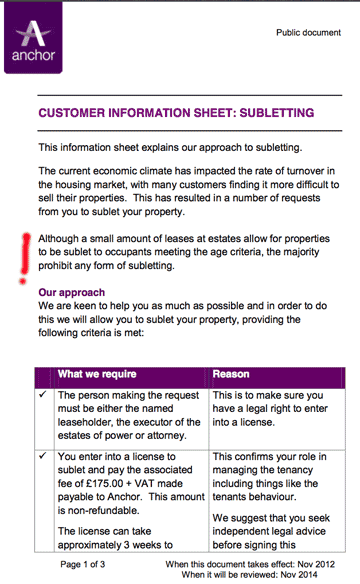
Bicester House, where the majority of residents do not wish to allow any sub-letting of the 44 properties
Residents at an upmarket retirement development in Oxfordshire are incensed that the Anchor Trust appears to be intent on permitting sub-letting even though this may be in breach of the lease.
In a nationwide policy, Anchor Trust is allowing leaseholders, or their executors, to rent the properties in exchange for a fee of £175 plus VAT. This is more than double the £85 sub-letting fee at retirement developments agreed between the Tchenguiz Family Trust and the Office of Fair Trading, while the Land Tribunal has ruled that £40 plus VAT is reasonable in the non-retirement sector.
But these are fees where sub-letting is permitted in the lease. In an extraordinary twist, Anchor Trust is fully aware that its policy, issued with immediate effect and to be reviewed in November 2014, may be in breach of the lease of many of its sites.
“Although a small amount of leases at estates allow for properties to be sublet to occupants meeting the age criteria, the majority prohibit any form of sub-letting,” it says.
The tenants must meet the age criteria of the site, pay service charges and contributions to the reserve fund. Another condition is: “We also ask that you check if the tenant has any convictions and ask that these be declared to us.”
The open liability of such as question is left unaddressed.
When the residents at Bicester House received the document they were horrified. Property values at the 44-unit converted Georgian house, with residential outbuildings, vary between £175,000 to £300,000.
“This is absolutely outrageous and we have no idea what Anchor Trust is thinking of,” says Stuart Barsby, 66, chairman of the residents’ association and a former senior policeman with Thames Valley.
An overwhelming majority of the residents – 37 against four – have voted to oppose the Anchor Trust policy. But the owner of one freehold house in the grounds, which also has a covenant against sub-letting, does want to introduce a tenant as her elderly relative has moved into care.
 “This is a pretty affluent retirement site, but it is not simply that we are worried about who the tenants might be,” said Barsby. “If Anchor Trust can do this in defiance of the residents’ wishes, what else could it come up with?”
“This is a pretty affluent retirement site, but it is not simply that we are worried about who the tenants might be,” said Barsby. “If Anchor Trust can do this in defiance of the residents’ wishes, what else could it come up with?”
Anchor area manager Katie Chesher told Barsby in an email that she copied into Leasehold Knowledge Partnership: “I also acknowledge that the residents feel that they should have been consulted but the new policy does not allow for residents to choose whether this is allowed.”
Barsby is being advised on the terms of the lease by James Cockle, of Covenant Management, a chartered surveyor accredited to LKP.
Campaign against retirement leasehold exploitation / LKP has no issue with residents and freehold owners at individual sites agreeing to allow sub-letting. It emerged at a recent meeting between Campaign against retirement leasehold exploitation and Age UK that this has been requested by leaseholders and is a symptom of the malaise in the retirement leasehold market.
As Anchor Trust says in its policy announcement: “The current economic climate has impacted the rate of turnover in the housing market, with many customers finding it more difficult to sell their properties. This has resulted in a number of requests from you to sub-let your property.”
An Anchor Trust spokesperson said: “We have received one formal complaint about our decision to allow sub-letting in certain circumstances at Bicester House. This is being dealt with via our complaints procedure and we are looking into the issue in detail. We will respond fully to the individual concerned when that process is complete.”
In the past, Campaign against retirement leasehold exploitation / LKP has been critical of Anchor Trust, whose previous chief executive John Belcher was on a widely-criticised salary of £391,000 per annum. The current chief executive is Jane Ashcroft, and Anchor is the largest “not-for-profit” housing association.
The Mail on Sunday reported in February 2011 that Anchor Trust sought to obtain additional revenue from keeping the proceeds of investing perhaps £10 million of leaseholder funds. They spent £5,000 asking lawyers whether it would be legal to do so.
The Mail on Sunday report can be read here
-
Stuart Barsby’s lease says:
-
Section 4.6.1 Not to assign or dispose of the dwelling except as a whole nor to underlet or otherwise part with possession of the whole or any part of that dwelling.
-
The Fifth Schedule – Regulations as to the use of the Dwelling and facilities within the Estate.
-
Section 6. Not to use the Dwelling otherwise than for private residential use in the occupation of the Lessee only or the Lessee and some other retired person.
The full Anchor Trust document on sub-letting can be read here:























I cannot believe what I am reading about Anchor. If it states in the lease no sub-letting then so be it. The Anchor executives need to face the public about and may need to be wearing body armour.
The covenants were put into the leases by the builder to maximise their their selling prices and profit. But is this “no sub-letting” clause really good for the existing leaseholders ? 37 leaseholders at Bicester House seems to think so. Are they right?
If you have a property at Bicester House and no longer able or want to live there, then you would try to sell and recover your investment. But If there are no willing buyers because of “adverse market conditions”, then the next best solution would be to sub-let until the property market becomes more favourable. However, if the other leaseholders insist “no-subletting” , the last resort must be to sell at whatever price level will find a buyer. Forced selling can cause the property sale price to drop 25-50% and substantial loss for the property owner. But the secondary effect is that every other flat in Bicester house may lose 50K in market value. So by insisting on full compliance to a no “sub-letting” clause can cause a loss of 43 units x 50K = £2.15m of property value.
Anchor Trust have a responsibility to protect the capital values of the properties for their owners and so I think they have made the right decision.